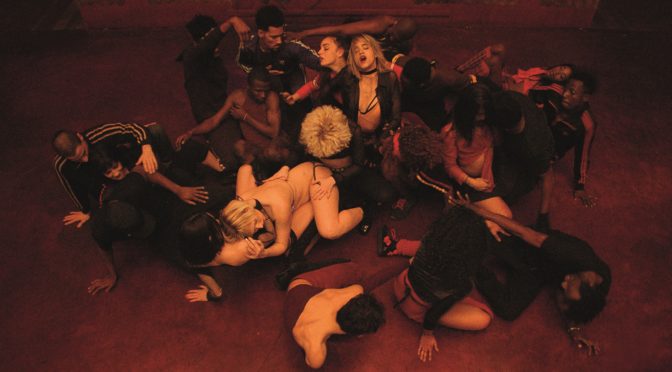CLIMAX is the latest incendiary offering from the mind of provocateur Gaspar Noé. When a supposedly safe haven for the artistically devoted is tainted by drugs, we become witness to a twisted hell dimension that is somehow both beautiful and horrifying.
The film centres around the last night of rehearsals for a French dance troupe, led by Selva (Sofia Boutella). Holed up in an empty boarding school in the middle of nowhere in the winter of 1996, the young dancers party while drinking from a bowl of sangria which is mysteriously laced with LSD. Their celebration turns into a nightmare of mass hysteria and violence.
At first, the plot sounds rather similar to that of Italian horror classic SUSPIRIA. However, make no mistake – CLIMAX is an entirely different, strange beast: one that immediately sucks you in on its own merit making it easy to forget any connection to the former. The first shot is of an immaculate white landscape, disturbed by a blood-stained girl collapsing into the snow. She writhes and screams, creating a snow angel of death.
You would think the film would play on the often-explored theme of lost innocence, but these characters are far from innocent. We cut to a continuous, hypnotic aerial shot of the dance hall, as the performers twist and contort their bodies in wild, stimulating positions. The dancers relish their youth, and indulge in their vices of sex, drugs and hip hop. The diversity of the group is refreshing: a vibrant concoction of personalities of different race, gender and sexuality. It is admirable to watch these characters discuss such adult topics, ranging from enlightened thought to obnoxious boasting. Leading the troupe is professional dancer Sofia Boutella, providing the first real demonstration of her range as an actor. After some lacklustre roles in blockbusters – the less said about Tom Cruise’s diabolical MUMMY reboot the better – Boutella is utterly convincing as the normally dominant Selva, who showcases a spectrum of emotions throughout her drug-fuelled frenzy. Despite her status, she never outshines the other performers, allowing them to take centre stage while she remains in the background during dance numbers.
The direction is astounding, fully immersing the viewer in this psychedelic nightmare. The dance hall becomes an asylum, its winding corridors like a maze similar to that of Kubrick’s THE SHINING. The camera tilts and rotates; the finale an extended upside-down sequence, as if the dancers hang from the ceiling. Noé delights in mixing birth with death; two equally alluring outlets. One pregnant dancer and another single mother fear for their children’s lives, while others reveal their true forms, from amorous to vampiric. This is a rebirth of humanity; animals giving into their primal urges as if nothing else matters. All that exists is the moment, and it is simultaneously shocking and glorious.
Yet the film is more than mere shock-horror. It is a social commentary on youth and sexuality, and both a celebration and condemnation of what happens when a person gives into their deepest, darkest urges. CLIMAX evokes the themes of several artists, from Lars Von Trier to Bret Easton Ellis. There is a sequence intercutting between various conversations about love and excess that evokes the youthful disillusionment of RULES OF ATTRACTION. Noé’s dance troupe are gleeful social misfits, shunned creatures let out to play. This is the type of film that makes you want to become a filmmaker.
CLIMAX is bound to divide audiences. There is little story progression and it is often claustrophobic. The dancers’ actions are a perfect metaphor for the audience – some will embrace its oddities, others will run for the exit. Yet for those seeking a dark tale of diversity and debauchery, the film stands as a sensory epic.
CLIMAX screened courtesy of Dundee Contemporary Arts.

